The Long Voyage Home
| The Long Voyage Home, produced by Walter Wanger and directed by John Ford, is critically acclaimed as the best film adaptation of one of playwright Eugene O’Neill’s classics. The film stands as one of Hollywood’s best dramatic creations. Ned Scott saved a number of items from the movie production along with some of his favorite photographs. These include portraits of American artists who painted scenes from the production process, something Hollywood producers had never done before. Scott also photographed a few of their paintings as well. Walter Wanger exhibited these paintings in art galleries around the nation to promote the movie. Many publications of the day immortalized this new feature in Hollywood movie making in their respective papers and magazines. American Artists magazine, issue September 1940, is the most complete discussion of the effort. Here the magazine article is displayed along with Scott’s portraits of the artists and his photographs of some of their paintings. These are followed by Scott’s still photographs from the film. This film was one of John Ford’s favorites of the many films he directed. For many years, Ford kept prominently displayed in his home a large group of the film stills which Ned Scott produced. He also kept the painting of himself which Georges Schreiber painted on the set. Scott’s color photographs of these paintings provide the only accessible rendering of what they were like in real life. Available literature does not provide any hint as to the eventual dispostion of these paintings following their parade on the national museum exhibit circuit after the film’s debut. It is a fact that researchers have failed to locate them. Until they do, these color phtographs by Ned Scott will serve as honest depictions of their Hollywood grandeur. |
American Artist MagazinePaintersCharacter PortraitsMovie Scenes |
American Artist Magazine |
 |
      |
     Text of Magazine Article: A rousing drama of the sea based on four of Eugene O’Neill’s stirring one-act plays was in the process of production in Hollywood. The story, written by Dudley Nichols, takes its title “The Long Voyage Home” from one of these plays. It is the saga of the “Glencairn”, a British freighter which sails from the tropics on a long and adventurous voyage through the dangerous waters of a war zone to her home port. The ill-fated ship carries a cargo of dynamite and a crew of men who, with no shore leave during the voyage, experience a dramatic range of human emotion and offer a tragic character study, as directed by that genius of character portrayal in motion pictures, John Ford famed especially for his “Stagecoach” and “The Grapes of Wrath”. “The Long Voyage Home” was under production n the studio of Walter Wanger, one of the most progressive and courageous producers in Hollywood. Wanger always had felt that sooner or later there would be a motion picture film so full of human interest, emotional experience and scenic flavor that it would offer stimulating material for artists to interpret and record on canvas. “the Long Voyage Home” impressed him as the perfect film for this. That is how it came about that nine American artists: Thomas Benton, Grant Wood, George Biddle, James Chapin, Ernest Fiene, Robert Phillip, Louis Quintanilla, Raphael Sawyer and Georges Schreiber were brought to Hollywood on the largest commission ever given by the motion picture industry to American art. Involving more than $50,000, this commission was offered to the artists by Mr. Wanger through Reeves Lowenthal, director of the Associated American Artists, then in California with an exhibition of American paintings. There were three specifications–first, that the artists were to have complete freedom of choice of what they were to paint. Second, they were to have studios on the movie lot and a projection room in which to view each day’s rushes. Third, they were to have access to all the sets during the filming–for purposes of sketching–and the cast would be available, any time, in costume, for sittings. Out of this situation, which would seem to be an artist’s conception of paradise, eleven paintings resulted–canvasses which, even if they add no luster to the artist’s renown, are hot gravy for the publicity being whipped up by the Hollywood producers and the Associated American Artists of New York. At any rate, the whole performance was a great lark for the artists and it made a real Alice-in-Wonderland story for the feature writers. For American Artist readers it offers a dramatic study in creative approach by nine prominent painters and demonstrates their contrasting technics and procedures. The promoters of the enterprise envision this alliance with the of the picture industry with the art of painting as a forerunner of a whole new field of income for artists. The paintings in turn will serve the film well. It will emphasize its dramatic values. And the artists’ interpretations will encourage the public to search the film from an entirely new angle, from the artist’s angle, seeking that which is especially significant in action and characterization. The pictures and story on the nine following pages give a vivid account of the unusual art project and reveal the painting methods of these prominent American artists. The paintings will go on exhibition first in New York at the Associated American Artists Galleries, 711 Fifth Avenue, and then will tour American through the museums. GEORGES SCHREIBER’S HOLLYWOOD CANVAS On the last leg of its dramatic sea journey through the war zone to London, the crew of the S.S. Glencairn is bombed and machine-gunned by enemy planes when within sight of land. Schreiber, who well remembers Belgian bombing raids in the first World War, depicts the horror of the faces of John Qualen, Constantine Romanoff, Bob Perry and Thomas Mitchell as a bomb drops near the prow of their ship. This is he scene Georges Schreiber elected to pant in Hollywood. Commenting on his panting procedure, he says: “The Bombardment scene in ‘The Long Voyage Home” was painted in oil on canvas, size 30 x 40 inches. The drama of human emotion has always interested me. Having scene the film in production as far as it was at he time, I selected for my theme the subject which not only expressed what I felt most, on account of its timelessness, but a scene I had experienced many a time in reality in my childhood in Brussels in the first World War–bombardments by enemy planes. In the painting I tried to express the entire story in the expression of the men, eliminating every detail which had no immediate relation to the situation. I also kept the color scheme very quiet, for it is my belief that the more tension of feeling an artist portrays, the quieter his palette has to be. With ‘understatement” and ‘holding back’, an artists expresses drama. Overemphasis will turn his work into melodrama. The main characters in the painting are Thomas Mitchell and John Qualen, both of whom I studied at work on the set and of whom I made several sketches. Neither posed for the painting, for an intense emotional expression cannot be ‘posed’ it has to be interpreted by the artist with his ‘feeling’ and imagination. The painting was done in five days.” Of his portrait of John Ford, Schreiber said: “The portrait of John Ford was painted in oil on canvas in 40 x 50 inches. After observing Mr. Ford for two weeks, directing “the Long Voyage Home’, I selected the pose which was most typical of is activity. His clothes and cap were those he always wore during his work. They belong to the portrait of the man:I believe that the clothes in a portrait should be of the sitter’s choice, reflecting the sitter’s taste, rather than of the artist’s choosing for color effects. Mr. Ford posed about three hours for the head. A paid ‘stand-in’ corresponding to Mr. Ford’s figure was used for the body. This entire painting was also accomplished in five days. “ Georges Schreiber as born in Brussels, Belgium, in 1904. He experienced four long years of the horrors of World War before he could begin his career as an artist. He came to American and became a citizen of the United States as quickly as the law permitted. He is now one of America’s most talented painters and illustrators. Benton chose for his picture a scene in which the seamen of the S.S. Glencairn, ashore for the first time in months, express their utter contempt for the captain of a rival tramp, the Amindra, just about to leave the London docks. He shares the following with us concerning his interpretation of the episode” “This picture is the result of walking in on a picture where John Ford was directing an incident in the motion picture version of Eugene O’Neiil’s ‘The Long Voyage Home’. The incident is not pictured as it will appear in the screen drama because I worked at an angle different from that employed by the camera. I worked from behind the set.” |
Painters from The Long Voyage Home |
| Rafael Soyer |
  |
| Robert Phillip |
  |
| Georges Schreiber |
   |
| George Biddle |
  |
| Ernest Fiene |
  |
| A significant salute to Grant Wood by Argosy Productions and Walter Wanger: “Grant Wood is unquestionably one of America’s greatest contemporary artists. Born and raised in Iowa, this quiet, modest and scholarly man still maintains his studios close by the University of Iowa where he is a professor. After being the sole support for his family at the age of ten, Wood began his art stuidies in Cedar rapids, then went to Chicago Art Institute and later studied abroad. After serving as a camouflage artist with the U.S. Army in World War I, Wood developed a rugged styleof painting which he has completely reversed to become the foremost realist of his day. Wood creates but two or three pantings a year and only one of his canvasses remains outside a museum or private collection. More than any other artist Wood has the ability to capture the simple and spiritual qualities of American of the soil and his “American Gothis” and “Woman With Plant” are the two most frequently reproduced paintings of a decade. Wood joined eight other American artists recently in painting scenes inspired by the colorful John Ford Argosy picture, “The LOng Voyage Home”, by Eugene O’Neill, the largest group project in the history of American art. |
   |
| Judith Linden, who has a prominent role in John Ford’s Argosy Poduction ‘The Long Voyage Home’ (1940), looks on as Thomas Hart Benton, famous American artist, explains his work. Benton is one of nine disttinguished painters brought to Hollywood by producer Walter Wanger to paint principals and scenes from this Eugene O’Neill classic drama of the sea. |
 |
| The Painters From Left to Right: Ernest Fiene, Luis Quintanilla, Thomas Benton, George Biddle, Raphael Sawyer, Georges Schreiber, Robert Philipp, James Chapin. |
 |
Portraits from The Long Voyage Home |
| Arthur Shields as Donkeyman from “The Long Voyage Home” |
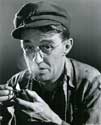 |
| Barry Fitzgerald as “Cocky”, the mess steward aboard the S.S. Glencairn. |
    |
| Constant Franke as “Norway”, a member of the shipboard black gang. |
  |
| Carmen Morales as a Spanish Girl providing romantic interest |
  |
| Constantine Romanoff as Big Frank, the Hairy Ape |
   |
| Douglas Walton as the second mate aboard the S.S. Glencairn |
 |
| Ian Hunter as “Smitty”, man of mystery aboard the S.S. Glencairn |
      |
| Jack Pennick as seaman “Johnny” |
  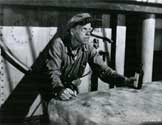 |
| John Qualen as seaman “Axel” |
   |
| Joe Sawyer as seaman “Davis” |
  |
| John Wayne as seaman “Ole” |
      |
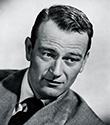 |
| Mary Carewe as “Smitty’s wife” |
 |
| Thomas Mitchell as the bosun aboard the S.S. Glencairn. |
    |
| Art Miles as the Captain of the cargo vessel Amindra. |
 |
| Unknown Actors |
  |
| Wilfrid Lawson as the Captain aboard the S.S. Glencairn |
    |
Movie Scenes from The Long Voyage Home |
| The Long Voyage Home movie scenes |
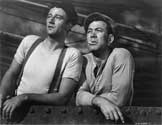  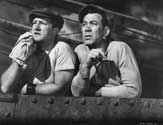 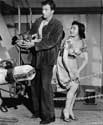 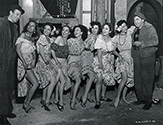 |
 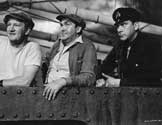 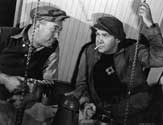 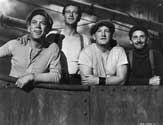 |
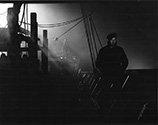  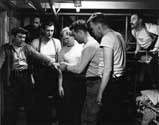 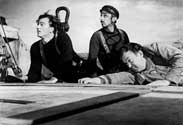 |
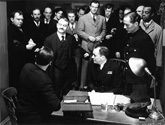  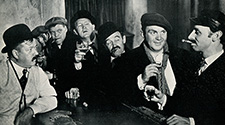 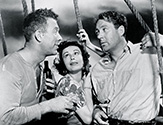 |
  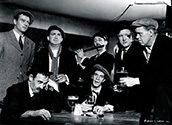  |
 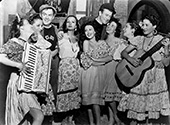 |
